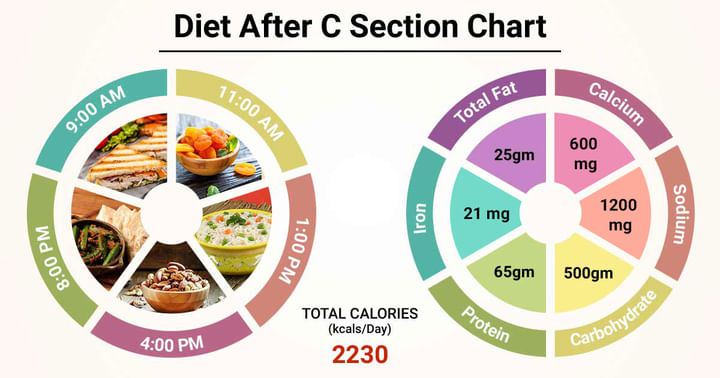Get the App
For Doctors
Login/Sign-up
About
Health Feed
Find Doctors
Diet Chart After C Section Delivery
Last Updated: Aug 06, 2020
About Diet Plan after C Section Delivery
Diet after C-Section is not the same as regular diet a person takes.
You can follow the below-given diet after C-Section:
- It should be full of important vitamins and minerals to foster faster healing of the mother. A healthy diet is also important to ensure the baby gets all the required nutrients through breast-feeding. The immediate diet after C-Section consists of a clear liquid diet and ice-chips to help get over nausea and get the digestive tract clear.
- Once the patient shows signs of a clear digestive system, with all the heavy drugs and narcotics out of the system and with proper passing of gas, the diet is gradually shifted to solid food.
- The solid food will comprise mainly of fruits rich in antioxidants such as oranges, grapes, and bananas to quicken the healing process, vegetables, especially leafy to enhance bowel movement, retain the lost nutrients and regain the energy lost in the process. Other components will be whole grains, basic milk products such as yoghurt, cottage cheese and tofu.
- Avoid eating pasta which is hard to digest, carbonated drinks and fried foods as they can increase constipation because there is already a lot of gas in the body after a C-section.
- There can be chances of blood loss during the operation, thus add food items high in iron content in your diet after C-section to maintain the hemoglobin level to a required level.
- It is important to keep the body hydrated, thus fluids such as soups, juices, buttermilk, coconut water and water must be consumed in order to keep the body functioning smoothly and avoid any scope of constipation.
Diet Chart for C Section Delivery Patients
| Sunday | |
| Breakfast (8:00-8:30AM) | Chicken sandwich(4 slice bread) + 1 cup milk. |
| Mid-Meal (11:00-11:30AM) | 5-6 dried apricots |
| Lunch (2:00-2:30PM) | Tofu Veg pulav rice 1.5 cup+ 1 cup Low fat curd. |
| Evening (4:00-4:30PM) | 1 fist full of groundnuts, raisins and almonds |
| Dinner (8:00-8:30PM) | 3 roti+ Ladies finger subji 1/2 cup. |
| Monday | |
| Breakfast (8:00-8:30AM) | Wheat dosa-3 + Egg roast 1/2 cup/ 1cup egg curry( 2 egg) |
| Mid-Meal (11:00-11:30AM) | plain Yoghurt with raw vegetables / grilled vegetables -1 cup |
| Lunch (2:00-2:30PM) | 4 Roti+1/2 cup salad + Fish curry (Mackerel 80 gm). |
| Evening (4:00-4:30PM) | 1 cup boiled sprouted chana dal with onion, tomato, lemon and corriander |
| Dinner (8:00-8:30PM) | 3 multigrain roti (oats, wheat, jowar)+ Tomato subji 1/2 cup. |
| Tuesday | |
| Breakfast (8:00-8:30AM) | Soya flour Uthappam 2 +Tomato /green chutney + 1 glass skimmed milk. |
| Mid-Meal (11:00-11:30AM) | 1 Portion fruit salad. |
| Lunch (2:00-2:30PM) | 1.5 cup parboiled rice+Kidney beans curry 1 cup + Tuna fry( 80g)+ Ladies finger subji 1/2 cup. |
| Evening (4:00-4:30PM) | 1 Cup light tea+ Brown rice flakes poha with nuts 1 cup. |
| Dinner (8:00-8:30PM) | Wheat dosa 3 + 1 cup Bitter guard subji. |
| Wednesday | |
| Breakfast (8:00-8:30AM) | Ragi dosa 2 + 1 tbs green chutney+ 1 boiled egg |
| Mid-Meal (11:00-11:30AM) | 2 medium size Orange |
| Lunch (2:00-2:30PM) | 4 chapati+Oyster roast(6 medium Oysters)+ french beans curry 1/2 cup+ cucumber salad 1/2 cup. |
| Evening (4:00-4:30PM) | 1 cup boiled sprouted moong dal with onion, tomato, lemon and corriander |
| Dinner (8:00-8:30PM) | Broken wheat upma 1 cup+ 1/2 cup drumstick leaves curry |
| Thursday | |
| Breakfast (8:00-8:30AM) | Mushroom Paratha 2 + Tomato chutney. |
| Mid-Meal (11:00-11:30AM) | 1 cup mixed sprouts (green gram, bengal gram, red gram) |
| Lunch (2:00-2:30PM) | 1.5 cup parboiled rice+ chicken curry( 150 gm chicken)+ Palak subji 1/2 cup+ 1/2 cup low fat curd. |
| Evening (4:00-4:30PM) | 1 cup orange juice. |
| Dinner (8:00-8:30PM) | 3 jowar roti+ 1/2 cup mix veg curry |
| Friday | |
| Breakfast (8:00-8:30AM) | Oats upma 1 cup + 1 boiled egg. |
| Mid-Meal (11:00-11:30AM) | 1 cup boiled black channa |
| Lunch (2:00-2:30PM) | 1.5 cup parboiledrice+ Mushroom curry 1/2 cup + Ladies finger subji 1/2 cup. |
| Evening (4:00-4:30PM) | 1 cup soya milk |
| Dinner (8:00-8:30PM) | 3 bajra roti+Ridge guard subji 1/2 cup. |
| Saturday | |
| Breakfast (8:00-8:30AM) | Paneer Paratha 3+ Green chutney. |
| Mid-Meal (11:00-11:30AM) | 1 cup banana and oats porridge |
| Lunch (2:00-2:30PM) | 1/2 cup parboiled rice + 3 medium chappati+ Fish masala 1 cup( Sardine 80 g)+ Snake guard subji 1/2 cup. |
| Evening (4:00-4:30PM) | 1 Portion fruit salad+ Yoghurt |
| Dinner (8:00-8:30PM) | Broken wheat upma 1 cup+ 1/2 cup green beans subji |
Food Items To Limit In C Section Delivery
- Carbonated drinks which may cause gas and flatulence should be avoided.
- Citrus juices should be taken with caution. You can initially take them in small amounts, and then increase it to moderate quantities.
- Caffeinated drinks like coffee and tea should be included in moderate amounts due to their diuretic properties. Also, the excess caffeine in them can lead to growth problems in your baby.
- Stay off from alcohol as it can impair your ability to produce milk and lead to developmental issues in your child.
- Do not eat fried foods as they are hard to digest, especially in the first days after delivery. They can cause indigestion, burns and gas.
- Do not take rice for at least three to four days after cesarean delivery, especially if you are diabetic. The high blood sugars from rice can interfere with the scar and may prolong the healing. Take brown rice as it supplies energy minus the extra calories.
- Avoid cold foods and drinks. They may make you catch a cold. As a lactating mother, you cannot take medication for cold as it can pass into the breast milk.
- Avoid gas-forming foods like white lentils, red kidney beans, chick peas, black-eyed beans, green peas. Avoid other gas-forming foods like cabbage, cauliflower, broccoli, lady’s finger and onions.
Do's And Dont's
Do's:
- Spread out your meals through the day instead of consuming three heavy meals. Try and have at least five to six small meals through the day.
- Have your meals at a gap of about two hours. In case you feel hungry earlier, snack on some fruits or nuts.
- With a newborn, you will never get enough sleep. So, try to rest whenever possible. Sleep will help your body repair and heal better.
- Try to eat more home cooked meals as you can and include lots of fresh ingredients.
- Follow your doctor's instructions for caring for the wound site. If the incision was closed with staples, stitches or glue, you can remove the dressings when you get home. For incisions closed with strips, change the dressing every day until the strips fall off. Wash the wound site gently with warm water and soap in the shower, but don't scrub it.
Don'ts:
- Avoid gulping down your food and instead take some time to chew it slowly. It may be difficult for you to have a relaxed meal while having a newborn around, but you can ask your family members to look after your baby for some time.
- Don't eat anything that is going to give you gas.
- Don't eat anything that is going to make you constipated.
- Avoid carrying heavy shopping bags.
- Try not to climb stairs or walk up steep inclines.
- Avoid driving a car for five or six weeks. You may not feel well enough to drive for up to six weeks after your caesarean, as turning and twisting may be awkward. If you need to make an emergency stop it could be very painful.
Food Items You Can Easily Consume after C Section
- Whole grain brown bread, brown rice, wheat and brown pasta provide you the necessary calories and help supply nutritious milk for your baby. It boosts the energy levels and gives you the required nutrients and vitamins. Enriched whole grain products contain folic acid, iron and fiber, which are essential in the early developmental stage of your baby. For new mothers who experience sleepless nights and wake up irritated in the morning, a whole grain cereal breakfast works.
- Proteins aid in the growth of new cell tissues and help in the healing process. Protein rich foods facilitate tissue repair and maintain muscle power after the surgery. You can eat fish, eggs, chicken, dairy foods, meat, peas, dried beans, and nuts. These foods are easily digestible, especially during your nursing time. Fish contain omega-3 fatty acids, and eggs provide zinc which is beneficial for your health.
- Citrus fruits like oranges and antioxidant-rich blueberries are good for breastfeeding mothers. Citrus fruits contain vitamin C. Green veggies like broccoli, spinach, pointed gourd, Indian round gourd, beans, fenugreek leaves and lotus stem are excellent sources of vitamins A and C, iron and dietary calcium. They contain heart-healthy antioxidants and low calories. Dark colored beans like kidney beans and black beans contain iron, which is essential for nursing mothers. They are also a source of non-animal protein. Mushrooms (fresh and dried), carrot and red dates are other good options.
- Skimmed milk, low-fat yogurt, and cheese are excellent sources of protein, calcium, and vitamins B and D, which are essential for nursing moms. You need calcium rich foods for yourself as well as your baby as your milk strengthens her. Include three cups or at least 500ml of dairy every day.
References
- Done WI. Cesarean section. Central District Health Department, 2019 [Internet]. centraldistrict.ne.networkofcare.org. [Cited 01 July 2019]. Available from:
- Schmidler C. Nutrition and Diet After Cesarean Birth, 2018 [Internet]. healthpages.org. [Cited 01 July 2019]. Available from:
- Diet Plan After C-Section- What to eat & What to avoid. Baby Destination. [Internet]. babydestination.com. [Cited 01 July 2019]. Available from:
Book appointment with:
Delhi
Mumbai
Chennai
Bangalore
Index
Table of content
Content Details
Written ByDrx Hina FirdousPhD (Pharmacology) Pursuing, M.Pharma (Pharmacology), B.Pharma - Certificate in Nutrition and Child CarePharmacology
Reviewed By
Find Dietitian/Nutritionist near me
Ask a free question
Get FREE multiple opinions from Doctors
posted anonymously



